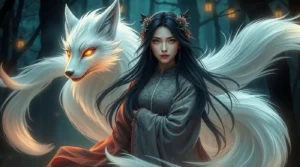Introduction/Summary
The Fenghuang, often referred to as the Chinese Phoenix, stands as a prominent figure in Chinese mythology, symbolizing high virtue, grace, and the harmonious balance of yin and yang. This mythical bird embodies the essence of righteousness and benevolence, appearing only during times of peace and prosperity. Its intricate symbolism and majestic imagery have woven it deeply into the cultural fabric of China, influencing art, literature, and philosophy for centuries.
History/Origin
The origins of the Fenghuang trace back to ancient Chinese texts and artifacts. Early references appear in oracle-bone inscriptions from the Shang dynasty (c. 1600–1046 BCE), indicating its longstanding significance in Chinese culture. Initially, the Fenghuang was depicted as two distinct entities: ‘Feng’ representing the male and ‘Huang’ the female, together symbolizing the harmonious union of yin and yang. Over time, these two aspects merged into a single, androgynous entity embodying balance and duality.
Throughout various dynasties, the Fenghuang’s symbolism evolved. During the Han dynasty (206 BCE–220 CE), it became associated with the empress, complementing the dragon, which symbolized the emperor. This association underscored the bird’s representation of feminine virtues and its role as a symbol of imperial power and harmony.
Name Meaning
The term ‘Fenghuang’ (凤凰) combines ‘Feng’ (凤) and ‘Huang’ (凰), originally denoting the male and female aspects, respectively. This duality reflects the concept of yin and yang, fundamental to Chinese philosophy, representing the interdependence and balance of opposites. The amalgamation of these aspects into a single term signifies the unity and harmony that the Fenghuang embodies.
Appearance
Descriptions of the Fenghuang depict it as a composite of various birds, each part symbolizing different virtues:
Head: Resembles that of a golden pheasant, representing virtue.
Beak: Similar to a rooster’s, symbolizing duty.
Neck: Like that of a snake, denoting flexibility.
Back: Comparable to a tortoise’s, signifying longevity.
Tail: Fans out like a peacock’s, embodying beauty and grace.
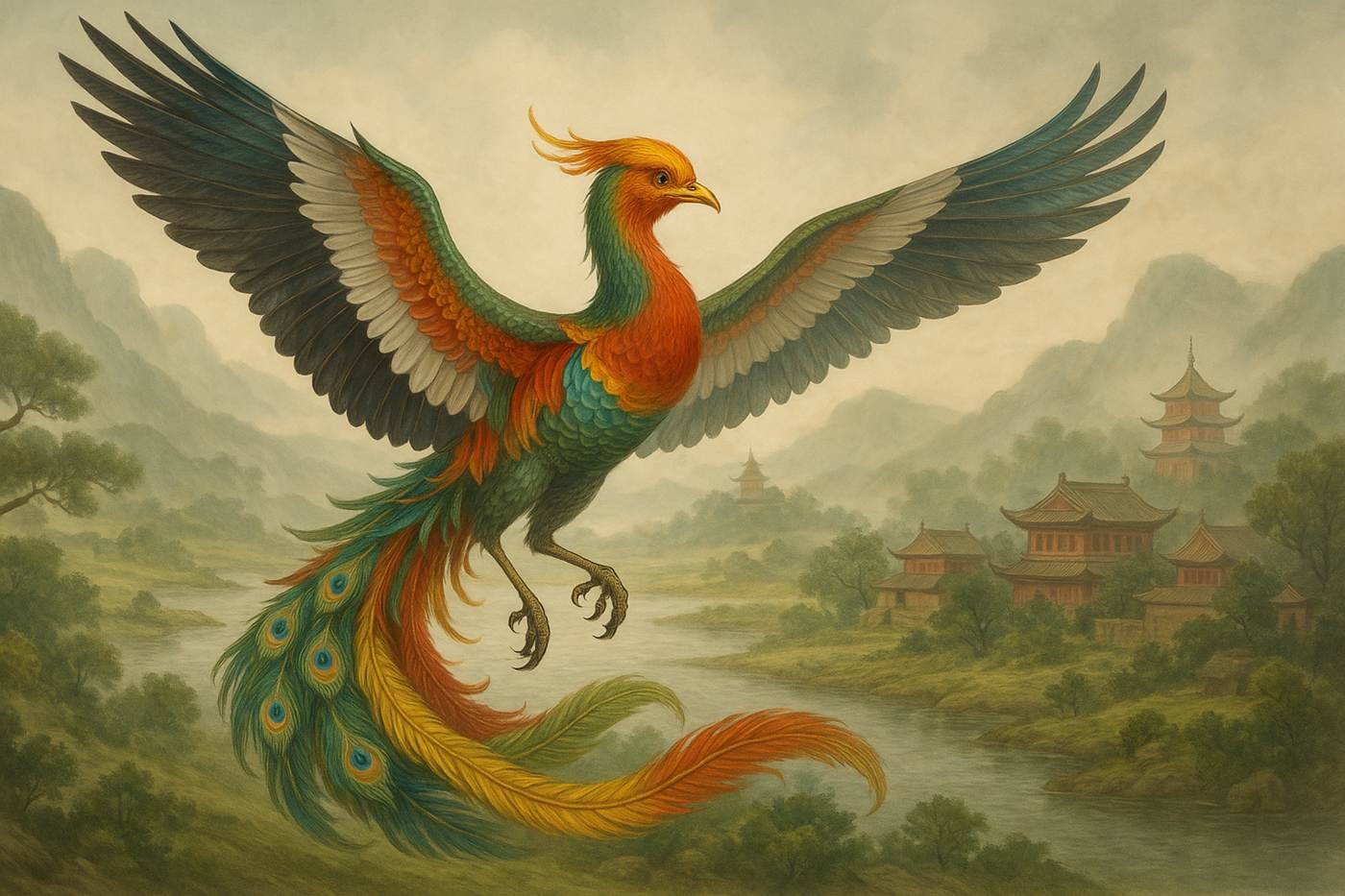
The Fenghuang’s plumage is adorned with the five fundamental colors—black, white, red, green, and yellow—each representing one of the five virtues: benevolence, righteousness, propriety, wisdom, and fidelity. This vibrant and symbolic coloration reinforces its role as an emblem of moral excellence and celestial harmony.
Background Story
In Chinese mythology, the Fenghuang is revered as the ruler of all birds, residing in the highest heavens and descending to Earth only during times of peace and prosperity. Its appearance is considered an auspicious omen, signaling the arrival of a virtuous leader or the beginning of a harmonious era. Legends describe the Fenghuang as a gentle creature that feeds exclusively on bamboo seeds and nests only in the most peaceful and serene environments, further emphasizing its association with purity and tranquility.
The Fenghuang’s role extends beyond that of a mere mythical creature; it embodies the ideal qualities of a just and benevolent ruler. Its image serves as a reminder of the virtues that leaders should aspire to, promoting a governance rooted in morality and harmony.
“The Fenghuang has very positive connotations. It is a symbol of high virtue and grace. The Fenghuang also symbolizes the union of yin and yang.”
This passage encapsulates the essence of the Fenghuang, highlighting its embodiment of virtue and the harmonious balance of opposing force
Famous Folklore Stories
The Fenghuang, often referred to as the Chinese phoenix, has been a symbol of virtue, grace, and harmony throughout Chinese history. Its appearances in folklore are considered auspicious, heralding times of peace and prosperity. Below are some notable stories that highlight the significance of the Fenghuang in Chinese culture.
The Appearance of the Fenghuang During Emperor Yao’s Reign
Emperor Yao, one of the legendary sage-kings of ancient China, was renowned for his wisdom and virtuous rule. It is said that during his reign, the Fenghuang appeared, signifying a period of unparalleled harmony and prosperity. The people took this as a divine affirmation of Yao’s benevolent governance and the flourishing state of the empire.
“During the time of Emperor Yao, the Fenghuang descended upon the royal gardens, its five-colored plumage shining brilliantly, a testament to the emperor’s virtuous rule.” (Classic of Mountains and Seas, 4th century BCE)

The presence of the Fenghuang during Yao’s reign reinforced the belief that this celestial bird’s appearance was a harbinger of peace and a reflection of the ruler’s moral integrity.
The Fenghuang and the Discovery of Precious Resources
In ancient times, it was believed that the Fenghuang would only alight in areas blessed with exceptional virtue or hiding precious treasures. One such tale tells of a man who witnessed the Fenghuang descending upon a particular patch of land. Intrigued by this event, he decided to investigate the area further.
“The Fenghuang perched gracefully upon the earth, its presence revealing the hidden wealth beneath.” (Collected Legends of the Phoenix, Han Dynasty)
Upon digging at the spot where the Fenghuang had rested, the man discovered a rich vein of salt, a valuable commodity in ancient China. This story exemplifies the belief that the Fenghuang’s presence could lead to the uncovering of hidden riches and was a symbol of forthcoming prosperity.
The Harmony of the Dragon and the Fenghuang
In Chinese mythology, the dragon and the Fenghuang are often depicted together, symbolizing the perfect balance of yin and yang. A well-known legend speaks of a time when these two majestic creatures appeared simultaneously, marking the beginning of a golden era.
“In the days of old, the Dragon and the Fenghuang danced together in the heavens, their union bringing forth an age of peace and unity among the people.” (Annals of the Celestial Kingdom, Tang Dynasty)
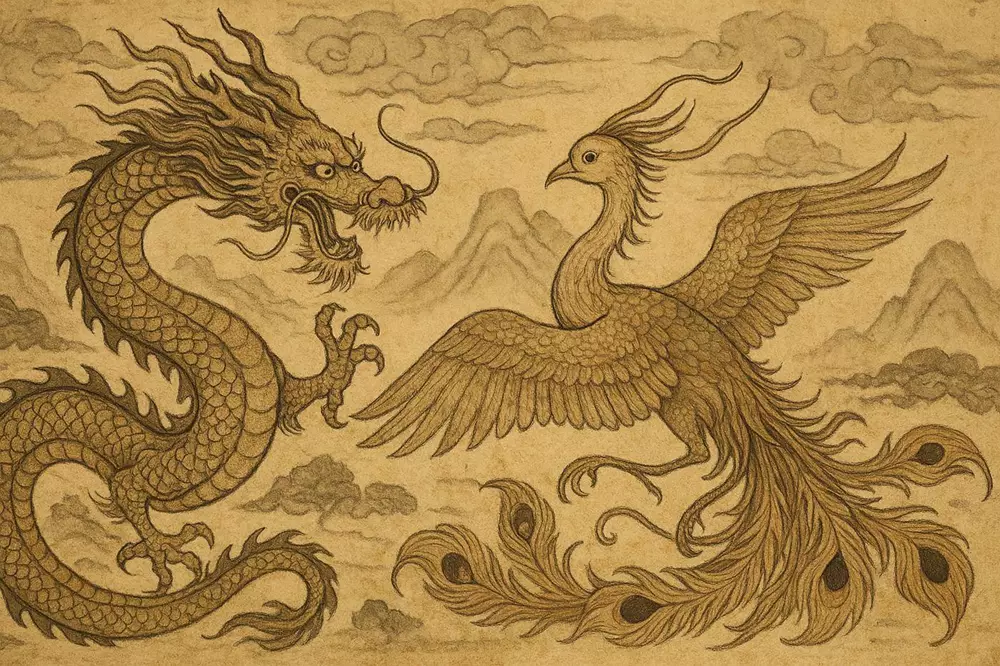
This tale underscores the importance of balance and harmony in governance and society, with the dragon representing power and strength, and the Fenghuang embodying virtue and grace. Their combined appearance was seen as an auspicious sign of a prosperous and harmonious era.
Cultural Impact
The Fenghuang, often referred to as the Chinese phoenix, holds a significant place in Chinese culture, symbolizing virtue, grace, and harmony. Its influence permeates various aspects of society, from art and literature to architecture and fashion.
Art and Literature
Throughout Chinese history, the Fenghuang has been a prominent motif in artistic expressions. Its image adorns ancient paintings, sculptures, and textiles, often depicted alongside the dragon to represent the balance of yin and yang. In literature, the Fenghuang embodies noble qualities, serving as a metaphor for virtuous individuals and harmonious governance. The bird’s association with peace and prosperity has inspired poets and writers to evoke its imagery when depicting idyllic times.
Architecture
The Fenghuang’s symbolism extends to architecture, where its likeness is incorporated into the design of imperial palaces, temples, and tombs. These depictions serve as auspicious symbols, believed to invite blessings and protect against negative influences. The presence of the Fenghuang in architectural elements underscores its role as a guardian of harmony and balance.
Fashion and Jewelry
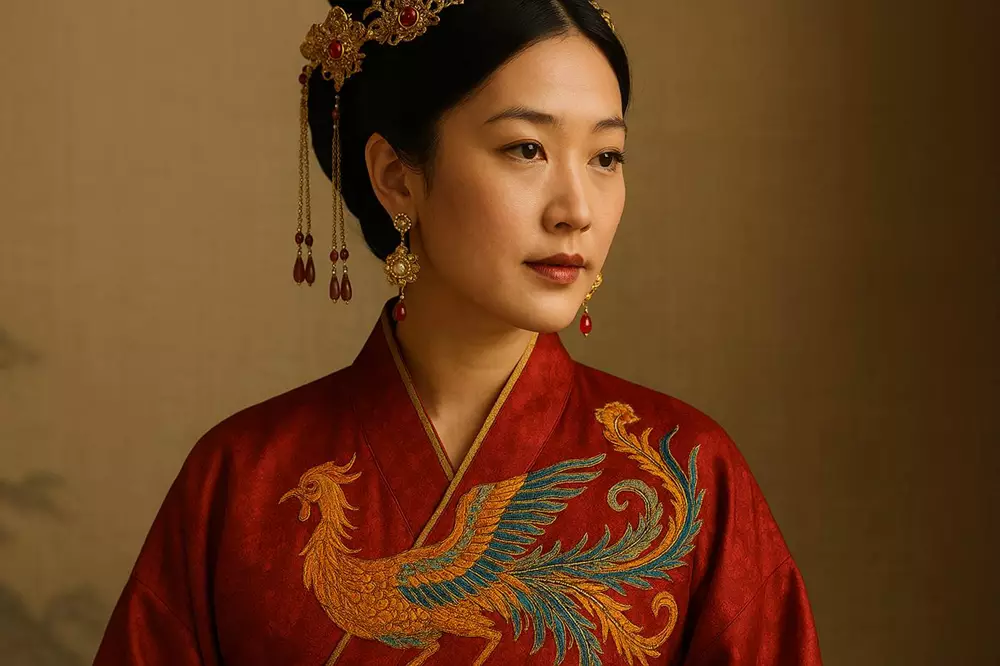
In traditional Chinese fashion, the Fenghuang motif embellishes garments, particularly those associated with royalty and significant ceremonies. Empresses and noblewomen often wore robes and accessories featuring the Fenghuang, symbolizing grace and virtue. This practice highlights the bird’s association with feminine beauty and nobility.
Weddings

The Fenghuang plays a pivotal role in Chinese wedding traditions. Paired with the dragon, it represents the harmonious union between husband and wife, embodying the balance of complementary forces. This symbolism is prevalent in wedding decorations, attire, and rituals, emphasizing the cultural value placed on marital harmony.
Similar Beasts
The concept of a mythical bird symbolizing various virtues and embodying significant cultural meanings is not unique to Chinese mythology. Several cultures feature analogous creatures that share similarities with the Fenghuang.
Phoenix (Greek Mythology)
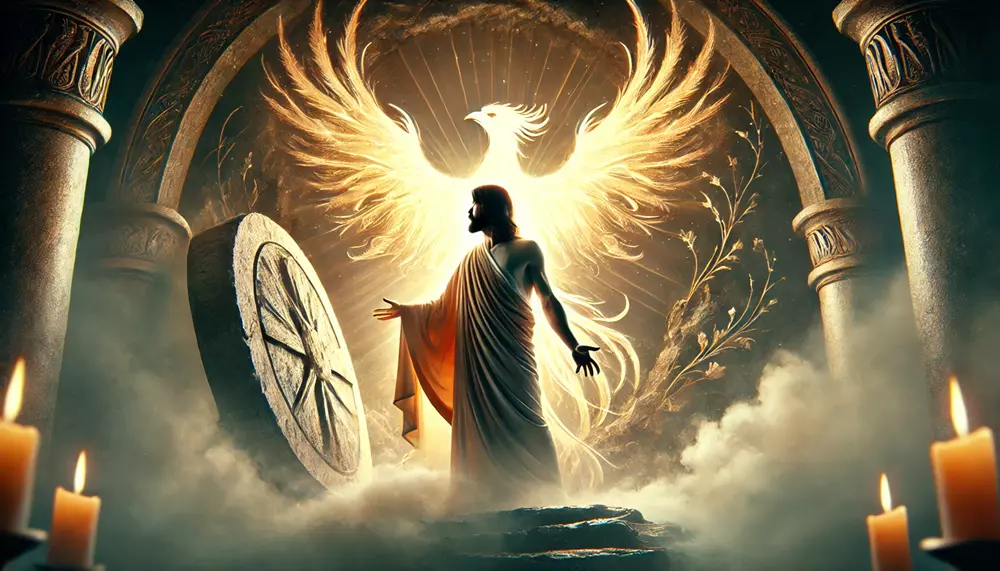
Perhaps the most renowned counterpart, the Greek phoenix is a mythical bird associated with the sun and rebirth. Unlike the Fenghuang, which symbolizes harmony and virtue, the Greek phoenix is famed for its cycle of death and resurrection, rising anew from its ashes. This theme of renewal has made the phoenix a universal symbol of resilience and immortality.
Garuda (Hindu and Buddhist Mythology)
In Hindu and Buddhist traditions, Garuda is a divine bird-like creature serving as the mount of Lord Vishnu. Garuda symbolizes power, speed, and martial prowess, often depicted as a protector against evil. While the Fenghuang represents peace and balance, Garuda embodies strength and vigilance.
Simurgh (Persian Mythology)
The Simurgh is a benevolent, mythical bird in Persian mythology, often depicted as a peacock with the head of a dog and the claws of a lion. It possesses immense wisdom and purifies the land and water, much like the Fenghuang’s association with virtue and auspiciousness.
Ziz (Jewish Mythology)
The Ziz is a giant, celestial bird from Jewish mythology, said to be so large its wings can block out the sun. Like the Fenghuang, the Ziz symbolizes divine protection and harmony. Both are peaceful, sky-dwelling creatures tied to cosmic balance, appearing in times of righteousness and often associated with sacred or prophetic events.
Religion/Ritual
The Fenghuang holds profound religious and ritualistic significance in Chinese culture. Its presence in ceremonies and spiritual practices underscores its role as an emblem of divine virtue and cosmic balance.
Imperial Symbolism
Historically, the Fenghuang was closely associated with the empress, complementing the dragon, which symbolized the emperor. This pairing reinforced the concept of yin and yang, with the dragon representing masculine energy and the Fenghuang embodying feminine grace. The empress’s use of the Fenghuang as a personal emblem highlighted her role as a paragon of virtue and the bringer of peace and prosperity.
Seasonal Festivals
During certain festivals, particularly those celebrating harmony and renewal, the Fenghuang’s imagery is prominent. Its representation during these events serves to invoke blessings and ensure a prosperous future.
Feng Shui
In the practice of Feng Shui, the Fenghuang is considered an auspicious symbol, believed to bring positive energy and ward off negative influences. Its image is often used in homes and businesses to attract harmony and success.
Scientific or Rational Explanations
While the Fenghuang is a mythical creature, scholars have explored possible inspirations and rational interpretations behind its legend.
Avian Inspirations
Some researchers suggest that the Fenghuang’s composite features may have been inspired by real birds native to China, such as the golden pheasant, peacock, and mandarin duck. The amalgamation of these birds’ most striking characteristics could have given rise to the majestic image of the Fenghuang.
Symbolic Creation
Others propose that the Fenghuang was conceived purely as a symbolic entity, embodying the highest virtues esteemed in Chinese culture. Its creation served as an allegorical tool to convey ideals of harmony, balance, and moral integrity.
Cultural Syncretism
The evolution of the Fenghuang’s symbolism may also reflect cultural syncretism, integrating various regional myths and symbols into a unified representation of virtue and auspiciousness.
Modern Cultural References
The enduring legacy of the Fenghuang continues to influence contemporary culture, with its imagery and symbolism appearing across various media. Below are notable examples:
Film
Mulan (2020): In Disney’s live-action adaptation of “Mulan,” the Fenghuang appears as a guiding symbol for the protagonist, representing her family’s values and her personal journey.

Television
Marvel Cinematic Universe: The Fenghuang is referenced in the Marvel universe as a phoenix-like creature native to the extradimensional realm of Ta Lo, known for its loyalty and compassion. appears in the series of ‘Shang-Chi’
Video Games
Final Fantasy Series: The Fenghuang, often localized as “Phoenix,” appears as a summonable creature, embodying themes of resurrection and healing, aligning with its mythical connotations of virtue and renewal.






